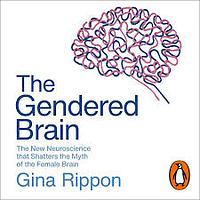Take a photo of a barcode or cover
227 reviews for:
The Gendered Brain: The New Neuroscience That Shatters the Myth of the Female Brain
Gina Rippon
227 reviews for:
The Gendered Brain: The New Neuroscience That Shatters the Myth of the Female Brain
Gina Rippon
I saw Professor Rippon give a talk about this book a few months ago, and have been itching to read it ever since.
It's a weighty tome - and deservedly so. It takes in the full history of ... https://shkspr.mobi/blog/2019/12/book-review-the-gendered-brain-by-gina-rippon/
It's a weighty tome - and deservedly so. It takes in the full history of ... https://shkspr.mobi/blog/2019/12/book-review-the-gendered-brain-by-gina-rippon/
challenging
hopeful
informative
inspiring
reflective
slow-paced
Moderate: Sexism
The topic is great, and it's full of interesting stuff, but for me the delivery was a bit boring, maybe a bit text book like.
challenging
informative
reflective
medium-paced
It seems then that I was wrong all along, reading books like "The female brain" by Louann Brizendine and similaria, led me to think that there really were differences between the male and the female brain, but now I know and it is not to late to be free from neurotrash and neurosexism, that rules these times. Brilliant book, that I hope to see up and long on the bestseller charts.
Sembra quindi che a forza di leggere libri tipo quello della Brizedine et sim. io mi sia sbagliata per lungo tempo riguardo all'argomento "differenze tra un cervello maschile ed uno femminile", ma per fortuna questo libro mi ha aperto gli occhi e non é mai troppo tardi per liberarsi da quello che l'autrice chiama "Neurotrash" e "Neurosexism". Non mi dispiacerebbe vedere questo libro in altro e per lungo tempo nella classifica dei libri piú venduti....
THANKS EDELWEISS FOR THE PREVIEW!
Sembra quindi che a forza di leggere libri tipo quello della Brizedine et sim. io mi sia sbagliata per lungo tempo riguardo all'argomento "differenze tra un cervello maschile ed uno femminile", ma per fortuna questo libro mi ha aperto gli occhi e non é mai troppo tardi per liberarsi da quello che l'autrice chiama "Neurotrash" e "Neurosexism". Non mi dispiacerebbe vedere questo libro in altro e per lungo tempo nella classifica dei libri piú venduti....
THANKS EDELWEISS FOR THE PREVIEW!
When I came across this book, I assumed (and hoped) that it would provide an insightful explanation for the psychological phenomenon of gender and its relation to our brains. That’s not what I got, but this book was intensely interesting nonetheless.
Gender and Our Brains is a meta-analysis of brain research by neuroscientists, psychologists, and others. It provides a very in-depth look into the history of brain science, particularly in relation to sex differences in the brain. From analyzing various bumps on the skull to advanced fMRI techniques, brain science has come a long way. However, one important stance that this book takes is that the field of brain science is deeply flawed and has much improving to do. Although science aims to remain objective, scientists are still people, and are therefore still susceptible to societal norms and biases about sex and gender, which can shape their research in misleading ways.
One of the most interesting and disheartening aspects of this book was its exploration into how societal pressures and stereotypes create gender gaps in STEM. As a woman in science myself, I do sometimes feel isolated from my male peers, although the situation is improving. It is clear that Gina Rippon, being a female neuroscientist herself, comes from a place of care and concern for the field in her analysis of how low self-esteem caused by gender stereotyping can dissuade young girls from pursuing careers in STEM-related fields.
My main problem with this book comes from its lack of discussion of how sex and gender are related. Although intersex is discussed briefly in several sections, it is not until the final chapter that transgender individuals are brought up. The discrepancy between outward sex and internal gender presentation is deeply fascinating, and could provide meaningful insights into how gender is affected by sex, and vice versa. Rippon does take the stance that sex and gender are a spectrum, but this idea could have been explored so much further. For this reason, I think the title of this book is misleading. Perhaps it should be changed to Sex and Our Brains, although I can see how that could easily be mistaken for a different book entirely.
Overall, Gender and Our Brains is a deeply fascinating and relevant book that everyone (especially parents of young children) could benefit from. It provides meaningful insight into the implications of sexism and gender stereotyping, and shows that a societal re-think of gender expectations is desperately in order.
Gender and Our Brains is a meta-analysis of brain research by neuroscientists, psychologists, and others. It provides a very in-depth look into the history of brain science, particularly in relation to sex differences in the brain. From analyzing various bumps on the skull to advanced fMRI techniques, brain science has come a long way. However, one important stance that this book takes is that the field of brain science is deeply flawed and has much improving to do. Although science aims to remain objective, scientists are still people, and are therefore still susceptible to societal norms and biases about sex and gender, which can shape their research in misleading ways.
One of the most interesting and disheartening aspects of this book was its exploration into how societal pressures and stereotypes create gender gaps in STEM. As a woman in science myself, I do sometimes feel isolated from my male peers, although the situation is improving. It is clear that Gina Rippon, being a female neuroscientist herself, comes from a place of care and concern for the field in her analysis of how low self-esteem caused by gender stereotyping can dissuade young girls from pursuing careers in STEM-related fields.
My main problem with this book comes from its lack of discussion of how sex and gender are related. Although intersex is discussed briefly in several sections, it is not until the final chapter that transgender individuals are brought up. The discrepancy between outward sex and internal gender presentation is deeply fascinating, and could provide meaningful insights into how gender is affected by sex, and vice versa. Rippon does take the stance that sex and gender are a spectrum, but this idea could have been explored so much further. For this reason, I think the title of this book is misleading. Perhaps it should be changed to Sex and Our Brains, although I can see how that could easily be mistaken for a different book entirely.
Overall, Gender and Our Brains is a deeply fascinating and relevant book that everyone (especially parents of young children) could benefit from. It provides meaningful insight into the implications of sexism and gender stereotyping, and shows that a societal re-think of gender expectations is desperately in order.
challenging
informative
reflective
slow-paced
DNF.
Didn’t hook me at the beginning, although there were some interesting passages I skimmed (maybe just read the conclusion and go read any chapters they summarize that sound interesting to you).
More frustrating was that twice (I convinced myself I was reading too much into it the first time) they had a real opportunity to look at the limited research on trans individuals and chose not to. It literally says this halfway through the book: ‘it is obviously ethically difficult to explore the causal role of hormones in humans by manipulating hormone levels and watching the effects’ and then goes on to describe literature on some DSD groups. Big, missed opportunity to really explore some interesting literature on people (who have provided informed consent to be on hormones!) and help describe the gaps that are there and would be worth filling.
At the very end they briefly mentioned that transgender people do exist, and that debunking a difference between male and female brains might help trans folk, but I still think there was not nearly enough time spent on this topic.
Didn’t hook me at the beginning, although there were some interesting passages I skimmed (maybe just read the conclusion and go read any chapters they summarize that sound interesting to you).
More frustrating was that twice (I convinced myself I was reading too much into it the first time) they had a real opportunity to look at the limited research on trans individuals and chose not to. It literally says this halfway through the book: ‘it is obviously ethically difficult to explore the causal role of hormones in humans by manipulating hormone levels and watching the effects’ and then goes on to describe literature on some DSD groups. Big, missed opportunity to really explore some interesting literature on people (who have provided informed consent to be on hormones!) and help describe the gaps that are there and would be worth filling.
At the very end they briefly mentioned that transgender people do exist, and that debunking a difference between male and female brains might help trans folk, but I still think there was not nearly enough time spent on this topic.
I thought it was going to be about gender identify and the brain, but it was almost exclusively about debunking so much of the nonsense that exists about the differences between men and women's brains. A key to understanding this book is to understand effect size, a statistical formula for looking at the significance of the difference between two sets. In reality most of the differences in brains have very small effect sizes, but both researchers and media act as if there are major differences.
While the book is good at debunking bad research, it's too long for its content and begins to get a tad boring. A more concise text with more information about the real differences, rather than a giant (yet, admittedly, needed) focus on the over-hyped, sexist, nonsense out there would have been more interesting.
A good, not great read with a nice touch of both humor and cynicism throughout.
While the book is good at debunking bad research, it's too long for its content and begins to get a tad boring. A more concise text with more information about the real differences, rather than a giant (yet, admittedly, needed) focus on the over-hyped, sexist, nonsense out there would have been more interesting.
A good, not great read with a nice touch of both humor and cynicism throughout.
It's quite difficult to write accessible neuroscience, however Gina has done it brilliantly, and with a little sarcastic humor rolled in (the advantages of writing for the lay audience rather than a scientific one). Very thoroughly referenced and clearly laid out summary of the evidence for, and mostly against the concept of a biological, neurological basis for the fe/male brain and an exploration of from where any differences that do withstand scrutiny may arise.






